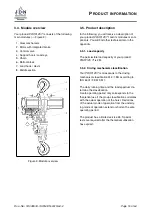
P
RODUCT INFORMATION
All control switches automatically return to the
neutral position when released. All movements are
stopped instantaneously and the load is securely
held in its current position.
3.5.7. EMERGENCY STOP device
The lifting and lowering motion is controlled di-
rectly from the rope control.
The control devices of the rope control and the
energy-switching part of the control valve on the
motor (reversing valve) are positively linked with
each other. This connection is designed so that
the control valve can be reset to a stable neutral
position in cases of emergency. This means that
no other EMERGENCY STOP device is neces-
sary.
3.5.8. Overload protection
DANGER
Danger from loads crashing
If the overload protection is set too high, unac-
ceptably high stresses can occur if a load is sus-
pended above the maximum load capacity. There
is a danger of the chain and device breaking!
I
Do not transport any overloads
I
Correctly set the overload protection.
In the event of overload, the overload protection
switches off the control pressure for lifting.
It reacts with a certain load-dependent delay and
is set to a limit value of about 125% of the nominal
load.
The overload protection is located in the control
valve.
After triggering the overload protection, lowering
is still possible - the load can be deposited and
reduced.
The overload protection can also respond if a load
that is to be lifted is approached at full idle speed,
even if this is below the set load size.
That is why we recommend making the slack
chain taught first before the load is lifted.
Page
16
of 64
Doc.-No.: VA049318-10-OM-EN-0319-64-2




































